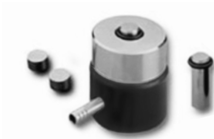KBr Pelleting :
in this methods, a small amount of sample (~ 1 - 2 mg) is mixed and ground along with about hundred times its mass of potassium bromide. The combination is transferred to an evacuuable die, to erase the moisture and then a high pressure is applied to yield a transparent pellet. It is put in a suitable holder and the whole assembly is placed in the line of the infrared beam.

Figure: Die assembly for making KBr pellets
Thin films: The IR spectrum of a thin film could be acquired through placing a sample of the film in a appropriate holder, such as a card along with a slot for the sample window. This technique is quite useful in the calibration of the instrument along with a standard like polystyrene for which the bands are accurately known.